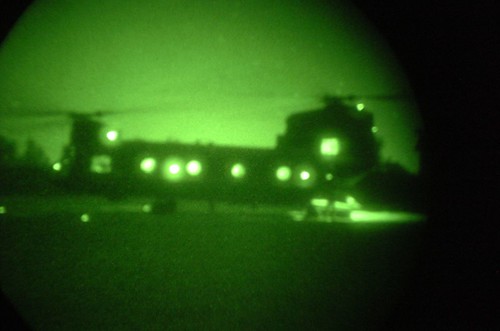
Bow your heads…
This weekend saw the deadliest day in the almost ten years of America’s war in Afghanistan, as well as the deadliest day in the history of the U.S. Navy’s Special Warfare community, when an Army CH-47 Chinook helicopter and crew carrying Navy SEALs and direct support personnel, Air Force combat controllers and pararescuemen, Afghan commandos and an interpreter went down in Wardak Province in eastern Afghanistan, apparently after being hit by a rocket-propelled grenade. The Associated Press is reporting that the helicopter carried an immediate reaction force that arrived on the scene to support an Army Ranger force that was engaged with the enemy on the ground, and that the crash happened during exfiltration after the fight had ended and the objective secured (ISAF has refuted this, saying that the chopper was shot down on ingress rather than on egress). As with last week’s New Yorker article on the bin Laden raid, people should only believe half at most of what they read or hear about this event and the circumstances surrounding it.
Naturally, the media – who pay attention to special operations once in the bluest of moons, and then proceed to get almost every detail wrong – are hyperventilating even more than usual about this tragedy because the helicopter was carrying operators from “SEAL Team Six,” more correctly known as the Navy Special Warfare Development Group, or “DEVGRU.” They’re also quick to report that no operators lost in this tragedy were participants in the famous May 1 raid that killed Osama bin Laden, as if (1) the tragedy is any less because the operators were different individuals than those, (2) those who took part in the bin Laden raid should be granted immunity from peril and death in perpetuity, and (3) these two missions were the only time SEALs or any other special operators had ever encountered risk or gone outside the wire. Points one and two are self-explanatorily ridiculous, while point three simply reinforces the drive-by nature of today’s media, and their pervasive attitude of treating anything that they didn’t find worthy of reporting at the time as though it never happened.
According to the AP, which cites a NATO source for the statistic, 2,832 special operations raids were carried out between April and July of this year alone. Regardless of its precision, that number should provide a general idea of just how common and routine these missions are for special operations units whose bread and butter is direct action and counterterrorism operations. In other words, just like high-value target (HVT) missions of the type that brought bin Laden to justice are daily occurrences for deployed special operators, so are the risks so horribly seen this weekend encountered on a daily and nightly basis for the entirety of military special operators’ careers. Over the course of ten years of special operations in Afghanistan, our enemies have had plenty of time to observe our tactics and to plan countermeasures. Conspiracy theories aside (such as the Admiral Ackbar-ish media claims that this was a “trap” set by Taliban), it’s entirely unsurprising that enemy fighters would have observed the routes used to infiltrate various sites and set up RPG-wielding fighters at points along them, hoping to catch a troop-carrying aircraft with a well-placed shot.
Additionally, helicopter crashes are far too common overall – let alone in the dangerous topographic and human terrain that make up Afghanistan – having claimed the lives of a significant number of crews and soldiers/sailors/airmen/Marines alike (I frequently say that I’ve lost more friends and former colleagues to helicopter crashes than to enemy fire, though this case appears to qualify as both). The eye-opening aspect of this incident is the sheer number of deaths, not the fact that a helicopter was apparently taken down while approaching what was evidently a hot LZ. It is interesting that the helicopter and crew were conventional, rather than from the 160 Special Operations Aviation Regiment that normally transports and supports Tier One special mission units, and the possibility – as yet unconfirmed – that the chopper and crew may have been from the Army National Guard raises further questions about the effect that an underpowered aircraft and a crew lacking experience in this type of direct action mission may have had on its tragic result. However, at this time this is simply an aspect of the case that bears watching and consideration; there is no evidence at this point that would support casting aspersions on chopper and crew for the tragedy that befell the military community as a whole this weekend. Evidently among the other augmentees on the mission were SEALs from one of the “white” Teams, which is not at all uncommon; the units the Air Force special operators came from have not been reported, though the 24th Special Tactics Squadron, which is incorporated into JSOC, usually provides the combat controllers and pararescuemen that operate as members of the command’s special mission units.
In their effort to conform to the scoop-outweighs-precision culture that our 24 hour media have created, numerous outlets ran to press and television without most (if any) facts about this incident. It took a full day for the public to have access to a narrative with any level of accuracy at all, an account by Navy Times reporter Sean D. Naylor which still stands as one of the best accounts available of the incident, albeit a brief and preliminary one. The rest of the story will eventually come out, likely in bits and pieces over the course of days, weeks, and months, though it will as usual be augmented with heavy doses of media chattering and speculation, most of which comes from a place of total ignorance on the subject.
In the interest of not contributing to that cacophany of ignorant chatter, I won’t offer any other up front comment on his situation, though I’ll be happy to update this post in response to questions posted in the comments, provided (1) I know the answer, and (2) doing so doen’t violate OPSEC in any way. I’ve also been addressing some questions and issues on Twitter since Saturday.
JE

CH-47 Chinook helicopter preparing for a night Air Assault in 2007. Photograph first published by Jeff Emanuel, September 3, 2007.














Join the conversation as a VIP Member